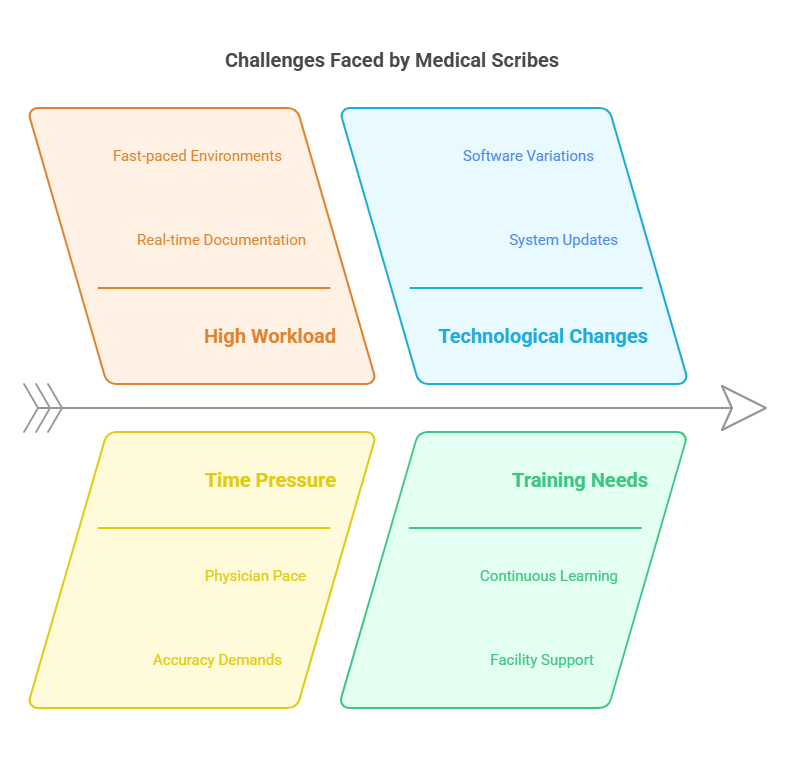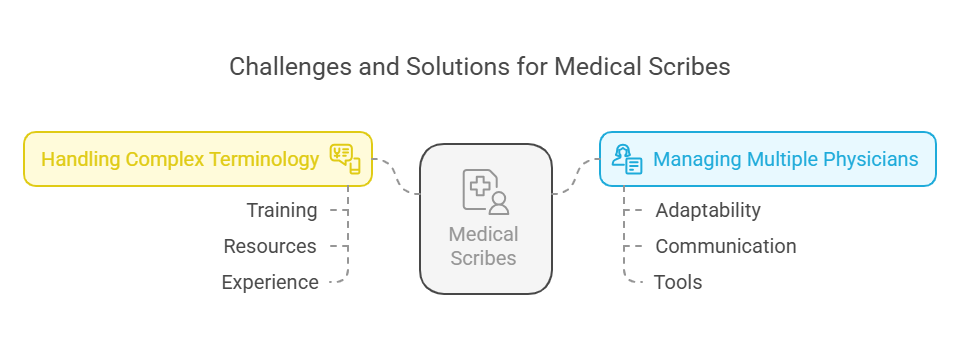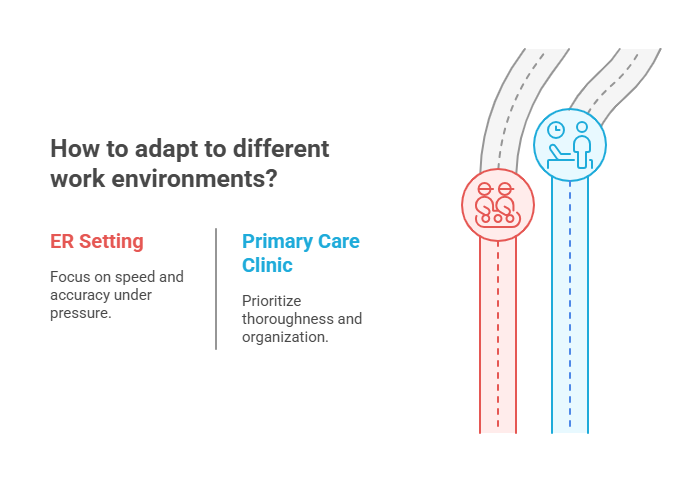What Are the Top Challenges Faced by Medical Scribes in Their Daily Work?
Medical scribes are an essential part of today’s healthcare system, helping healthcare providers with accurate documentation to maintain up-to-date patient records. This allows doctors to focus on patient care rather than spending valuable time on administrative tasks. However, while the role of a medical scribe is both critical and rewarding, it comes with its own set of challenges.
These challenges can impact not only a scribe’s performance but also their job satisfaction and overall well-being. The pressure to document quickly, the constant need to stay updated with evolving technologies, and the demands of working in fast-paced environments can create significant stress. In this blog, we’ll take a deeper look at the key challenges medical scribes face in their daily work and provide practical solutions and strategies to help them navigate these obstacles effectively, ensuring success and fulfillment in their career.
Managing High Workload and Time Pressure
One of the most immediate and prominent challenges faced by medical scribes is managing a high workload and constant time pressure. Scribes are responsible for documenting physician-patient encounters in real-time, often in fast-paced environments like emergency rooms (ERs), outpatient clinics, and specialty practices. The nature of the role demands that scribes capture detailed medical histories, diagnoses, procedures, and treatment plans during patient visits, all while maintaining a rapid pace.
In busy healthcare settings, physicians are constantly moving from one patient to the next, and medical scribes must work quickly to ensure that each record is completed on time. The pressure to keep up with the fast flow of patient visits while ensuring accuracy can quickly become overwhelming. Not only must scribes maintain speed, but they must also ensure that the information recorded is precise and comprehensive, which adds to the complexity of their job. When scribes are unable to manage their time effectively, the pressure can lead to mistakes, which may affect patient care or cause frustration in both the scribe and the healthcare provider.
Solution: To effectively manage this challenge, medical scribes must hone their time-management skills. One of the most effective ways to do this is through structured practice in real-time documentation. New scribes should focus on becoming familiar with common medical terminology and the various procedures performed in different specialties to streamline their work. As they gain experience, scribes naturally improve their typing speed and accuracy. They can also learn to use EHR shortcuts, templates, and predictive text features to save time without sacrificing quality. Moreover, effective communication with physicians is essential to ensure that all necessary information is captured correctly without redundancy or missed details.
Adapting to Constant Technological Changes
Healthcare technology is evolving at an unprecedented rate, and this presents a significant challenge for medical scribes. With each new system update, software upgrade, and integration of advanced technologies like artificial intelligence (AI), scribes must adapt quickly to ensure they are documenting in line with the latest tools and features. This can be especially difficult in environments where EHRs and other medical technologies are frequently updated or modified. When new features or software tools are introduced, scribes must quickly get up to speed, which can disrupt their established workflow and increase the risk of errors.
Moreover, the use of different software systems across healthcare facilities can create additional challenges, as scribes may have to switch between platforms, each with a unique interface and set of functions. These technological changes can cause confusion or slow down the documentation process, especially if scribes are not adequately trained or familiar with the new tools.
Solution: The key to overcoming this challenge is continuous learning and proactive training. Medical scribes should actively engage in refresher courses, attend workshops, and seek out online resources that cover the latest technological advancements in healthcare. Many certification programs offer updates and additional modules that focus on new technologies, helping scribes stay informed. In addition, healthcare facilities should provide ongoing training and support to ensure that their scribes are well-equipped to handle technological changes smoothly.
Handling Complex and Unclear Medical Terminology
Medical scribes are expected to be highly proficient in medical terminology to accurately transcribe patient records. From basic anatomy terms to complex medical procedures, understanding and documenting these terms is a critical part of their role. However, scribes frequently encounter complex, specialized, or unfamiliar medical terminology that can slow down their documentation process. When working in highly specialized fields such as cardiology, oncology, or neurology, the volume and specificity of medical terms can increase significantly, making it more challenging to keep pace with the physician.
Additionally, scribes sometimes encounter unclear or ambiguous terminology, especially when physicians use shorthand, acronyms, or non-standard abbreviations during their notes. Misunderstanding or incorrectly transcribing these terms can lead to significant errors in patient records, which could have serious consequences for patient care and safety. The pressure to capture every detail perfectly increases, making it even more essential for scribes to stay focused and accurate.
Solution: To handle this challenge, medical scribes undergo rigorous training in medical terminology. This foundation helps them understand common terms and their context, making documentation more efficient. However, when unfamiliar terms arise, scribes have several resources at their disposal, including medical dictionaries, glossaries, and online reference tools. They can also consult directly with the physician to clarify terms if necessary. Over time, scribes become increasingly familiar with specialized medical language through experience, which allows them to adapt to new terms and contexts more effectively. This ongoing learning ensures that scribes can manage even the most complex terminology with greater ease and accuracy.
Managing Multiple Physicians and Workflows
One of the unique challenges medical scribes face is the need to work with multiple physicians who each have their own style of documentation, preferences, and workflow. In a busy healthcare setting, scribes are often required to switch between different physicians’ styles in the same shift, leading to potential confusion and stress. Each physician may have specific ways of dictating notes, using particular abbreviations or focusing on different aspects of patient encounters. Scribes must be flexible and adaptable to handle these diverse demands, which can be challenging in high-volume environments where multiple physicians are seen in a short period of time.
In addition, healthcare providers often have varying expectations for how detailed or concise the documentation should be. Some physicians may prefer quick, high-level summaries, while others may demand extensive documentation with specific formatting. This variation can make it difficult for scribes to maintain consistency and quality in their work, particularly when dealing with a large number of patient visits.
Solution: Experienced medical scribes develop strong adaptability skills by learning the preferences and workflows of each physician they work with. Effective communication is essential for building a positive relationship with each physician, ensuring that the documentation aligns with their needs. Scribes often use tools such as templates, customizable notes, and shorthand to standardize their work while accommodating each physician’s preferences. Over time, as scribes gain more experience with different physicians and specialties, they become more skilled at quickly adjusting to new workflows without sacrificing the quality or accuracy of their documentation.
Dealing with Mental and Physical Fatigue
The role of a medical scribe is both mentally and physically demanding, and these demands can lead to significant fatigue, particularly during long shifts in high-pressure environments. The constant need for concentration to ensure that each detail of the patient’s information is accurately recorded can be mentally exhausting. This is compounded by the physical act of typing, which, when done for long periods, can lead to repetitive strain injuries like carpal tunnel syndrome or back and neck pain. When scribes are under constant pressure to meet deadlines and keep up with the pace of physicians, it can result in burnout, diminished job satisfaction, and a decrease in overall performance.
This kind of fatigue is not only harmful to the individual scribe but also can affect the quality of the documentation, leading to errors and inefficiencies. Furthermore, chronic fatigue can lead to emotional exhaustion, contributing to a sense of disengagement from the work. As scribes work long hours, especially in demanding medical settings like hospitals, it is essential that they take proactive steps to address the mental and physical toll the job can take.
Solution: To combat burnout, medical scribes should implement strategies for managing stress and maintaining physical well-being. Taking regular breaks throughout the day, stretching, and engaging in physical activities can help reduce physical fatigue and prevent strain injuries. Scribes should also focus on maintaining a healthy work-life balance by setting boundaries for their hours and making time for personal activities that rejuvenate them. Many healthcare organizations offer wellness programs that support mental and physical health, providing resources such as counseling services, stress management workshops, or ergonomic solutions for workstations. Creating an environment that encourages self-care can help scribes maintain their performance and stay motivated in their roles.
Balancing Speed and Accuracy
One of the biggest challenges medical scribes face is striking the right balance between speed and accuracy in their documentation. In fast-paced healthcare environments such as emergency rooms, outpatient clinics, and operating rooms, scribes must work quickly to keep up with the physician’s pace while ensuring that every detail is accurately documented. The need to type rapidly while capturing a thorough and precise record of patient interactions is a high-stakes balancing act. This is especially difficult when the physician is moving from patient to patient or when urgent care is required.
The pressure to document quickly can sometimes lead to mistakes, which could have serious consequences for patient care. A missed detail, a wrong entry, or an inaccurate transcription can result in errors that affect treatment decisions and, ultimately, patient outcomes. Scribes are often aware that even a minor mistake can have significant repercussions, making this challenge even more stressful.
Solution: The key to balancing speed and accuracy lies in the training process. Scribes must undergo rigorous training that emphasizes both speed and precision, with a focus on real-time documentation. As scribes gain more experience, they naturally improve their efficiency without sacrificing accuracy. By developing a deep understanding of medical terminology and becoming proficient in using electronic health record (EHR) systems, scribes can type faster while still capturing all the necessary information. Additionally, utilizing time-saving tools, such as templates, voice recognition software, and EHR shortcuts, can further increase efficiency. With time and practice, scribes become better at striking this delicate balance, ensuring that the documentation process remains both quick and precise.
Managing Incomplete or Unclear Notes
One of the most common challenges faced by medical scribes is dealing with incomplete or unclear notes provided by physicians. Physicians often have demanding schedules and may not have enough time to provide detailed or clear documentation during patient visits. As a result, scribes are left with partial or vague notes that may not fully capture the essential aspects of the patient encounter. In these cases, scribes must fill in the gaps, often having to make educated guesses or seek clarification from the physician. This process can slow down the workflow, as scribes may need to pause their work to clarify details, which can be particularly frustrating in fast-paced environments.
Unclear notes can arise for several reasons, such as shorthand, abbreviations, or rushed documentation, all of which can cause confusion. Moreover, missing details can impact the quality and accuracy of the patient’s medical record, potentially affecting future treatment decisions.
Solution: Clear communication between scribes and physicians is essential for overcoming this challenge. Scribes must feel comfortable asking for clarification when encountering unclear terms or gaps in the documentation. Having a good relationship with the physician helps build trust, making it easier for scribes to ask questions when necessary. Scribes can also rely on their medical knowledge and resources, such as medical dictionaries and online tools, to make informed guesses when unsure. Over time, scribes develop a better understanding of physicians' note-taking styles, which allows them to anticipate and handle incomplete notes more effectively.
Adapting to Different Work Environments
The nature of a medical scribe’s role can vary significantly depending on the work environment. Each healthcare setting presents its own unique set of challenges. For example, working in a fast-paced emergency room (ER) is quite different from working in a primary care clinic. In the ER, scribes are required to work quickly under intense pressure, documenting patient encounters as rapidly as possible while ensuring accuracy. The environment is often chaotic, with a constant influx of new patients and a variety of medical emergencies that require swift documentation. The urgency of this setting means that scribes must constantly stay alert and adjust to rapidly changing situations.
On the other hand, a primary care clinic usually involves a more structured, predictable workflow, with patients coming in for scheduled visits and ongoing care. While the pace may be slower, the documentation requirements can be more detailed, as physicians may need to provide comprehensive notes for chronic conditions or routine check-ups.
Solution: To succeed in these varied work environments, medical scribes must develop strong adaptability skills. This means understanding the specific demands of each setting and adjusting their workflow accordingly. In fast-paced environments like the ER, scribes may need to focus on speed and accuracy, while in more structured settings like a primary care clinic, they might prioritize thoroughness and organization. Regardless of the environment, developing excellent communication skills with physicians, staying organized, and maintaining flexibility are essential for scribes to thrive in different healthcare settings. With time and experience, scribes learn to navigate these varying demands and ensure that documentation is always completed to the highest standard.
Ensuring Patient Confidentiality and HIPAA Compliance
Medical scribes are entrusted with sensitive patient information and must ensure that they comply with strict HIPAA regulations. Maintaining patient confidentiality is always a priority, but it can sometimes be challenging when working in high-pressure or fast-paced environments.
Solution: Scribes receive extensive training on HIPAA compliance and patient confidentiality. By following established protocols, scribes can ensure that they handle patient information with the utmost care and security.
Staying Focused in High-Stress Situations
In high-stress environments, such as during medical emergencies or critical patient care situations, medical scribes must maintain focus and accuracy despite the chaos and urgency around them. The fast-paced nature of these situations can create significant mental fatigue, especially when scribes are required to document rapidly while absorbing large amounts of medical information in real-time. The pressure to perform accurately and efficiently can be overwhelming, and mistakes during such high-pressure moments can have serious implications for patient care. The emotional toll of dealing with critical conditions, along with the physical demand of continuous typing, can lead to burnout if not managed properly.
Solution: Developing mental resilience and staying calm under pressure are essential skills for medical scribes. Practicing mindfulness techniques, such as deep breathing exercises, can help scribes stay centered and focused during intense moments. Additionally, incorporating stress-management strategies like regular breaks, hydration, and stretching can help prevent physical and mental fatigue. Over time, with experience, scribes learn how to handle high-stress situations with greater composure and efficiency, ensuring that they can document patient information accurately, even in the most challenging circumstances. Building emotional and mental resilience is key to long-term success in this demanding role.
Conclusion: Navigating the Challenges of a Medical Scribe Career
While the role of a medical scribe can be challenging, it is also incredibly rewarding. By developing key skills like time management, adaptability, and effective communication, scribes can overcome these challenges and make a significant contribution to healthcare teams. Through programs like ACMSO, scribes gain the training needed to provide high-quality, accurate documentation that supports efficient medical practices and enhances the overall quality of patient care. Scribes become indispensable members of healthcare teams, improving workflows and ensuring that physicians can dedicate more time to patient interactions. The positive impact scribes have on patient outcomes and healthcare delivery makes their role essential and highly valued in the medical field.
Lesser-Known Facts About Medical Scribes:
Medical scribes can specialize in various fields, such as cardiology, orthopedics, and dermatology.
Certified scribes are often seen as more reliable and are hired quickly due to their expertise.
Some medical scribes work remotely, especially in telemedicine settings.
Medical scribes play a vital role in improving physician-patient communication.
How medical scribes enhance doctor-patient communication
The role of a medical scribe is one of the fastest-growing professions in healthcare.
Certification helps scribes advance in their careers by making them more competitive.
Medical scribes can work in both high-stress emergency room environments and calm clinic settings.
Scribes need to stay updated with evolving medical technologies and software.
The average salary of a certified medical scribe is higher than that of non-certified scribes.
Medical scribes often play an integral part in reducing medical errors by ensuring accurate documentation.
The role of medical scribes in reducing medical errors
FAQs:
-
Medical scribes face challenges such as managing high workloads, adapting to new technology, handling complex terminology, burnout, and balancing speed with accuracy. -
Scribes can manage burnout by taking regular breaks, practicing stress-relieving activities, maintaining a healthy work-life balance, and utilizing wellness programs offered by employers. -
Yes, medical scribes can work across a wide range of specialties, including cardiology, pediatrics, orthopedics, and emergency medicine, each with unique documentation needs.
-
Yes, the constant updates and changes to healthcare technologies, such as EHR systems, can be challenging for medical scribes. Continuous training helps them stay up-to-date. -
No, medical scribes do not need a medical degree. However, certification and training in medical terminology, EHR systems, and HIPAA compliance are essential to succeed in the role.






